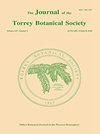Perforation plate pit membrane remnants in vessels of Sarraceniaceae: Possible indicators of relationship and ecology
IF 0.8
4区 生物学
Q4 PLANT SCIENCES
引用次数: 4
Abstract
SCHNEIDER, E. AND S. CARLQUIST (Santa Barbara Botanic Garden, 1212 Mission Canyon Road, Santa Barbara, CA 93105). Perforation plate remnants in vessels of Sarraceniaceae: possible indicators of relationships and ecology. J. Torrey Bot. Soc. 131: 1-7. 2004.-All three genera of Sarraceniaceae possess pit membrane remnants in perforations: the abundance of pit membrane remnants parallels the number of bars per perforation plate: most in Heliamphora, fewer in Sarracenia, fewest in Darlingtonia. Heliamphora perforation plates were reported earlier, so Darlingtonia (monotypic) and two species of Sarracenia are considered here. The majority of perforations lack extensive pit membrane remnants, but occasional meshwork-like remnants can be seen at the lateral ends of a number of perforations. Perforations intermediate in size and morphology between perforations and lateral wall pits (pit membranes nearly intact, but containing numerous pores) often occur at upper and lower ends of perforation plates. Pit membrane remnants of this type have been reported in scalariform perforation plates of families thought to be closely related to Sarraceniaceae (Clethraceae, Cyrillaceae, Ericaceae). Species of all four families in which pit membranes are present occur in highly mesic or bog habitats.菝葜科植物导管穿孔板坑膜残留物:可能的关系和生态学指标
施耐德,E.和S.卡尔奎斯特(圣巴巴拉植物园,使命峡谷路1212号,圣巴巴拉,CA 93105)。菝葜科植物导管穿孔板残留物:可能的关系和生态学指标。托里·博特。《社会科学》131:1-7。2004.- Sarraceniaceae的所有三个属在穿孔中都有坑膜残留物:坑膜残留物的丰度与每个穿孔板的杆数平行:Heliamphora最多,Sarracenia较少,Darlingtonia最少。Heliamphora穿孔板的报道较早,因此这里考虑的是Darlingtonia (monotypic)和Sarracenia两种。大多数射孔缺乏广泛的坑膜残留物,但偶尔在一些射孔的侧端可以看到网状残留物。穿孔的大小和形态介于穿孔和侧壁凹坑之间(凹坑膜几乎完整,但含有许多孔),通常发生在穿孔板的上端和下端。这种类型的坑膜残余物已在被认为与菝葜科(十字花科、西兰科、Ericaceae)密切相关的科的鳞片穿孔板中报道过。坑膜存在的所有四个科的物种都发生在高度mesic或沼泽生境中。
本文章由计算机程序翻译,如有差异,请以英文原文为准。
求助全文
约1分钟内获得全文
求助全文
来源期刊
CiteScore
0.70
自引率
0.00%
发文量
16
审稿时长
>12 weeks
期刊介绍:
The Journal of the Torrey Botanical Society (until 1997 the Bulletin of the Torrey Botanical Club), the oldest botanical journal in the Americas, has as its primary goal the dissemination of scientific knowledge about plants (including thallopyhtes and fungi). It publishes basic research in all areas of plant biology, except horticulture, with an emphasis on research done in, and about plants of, the Western Hemisphere.

 求助内容:
求助内容: 应助结果提醒方式:
应助结果提醒方式:


